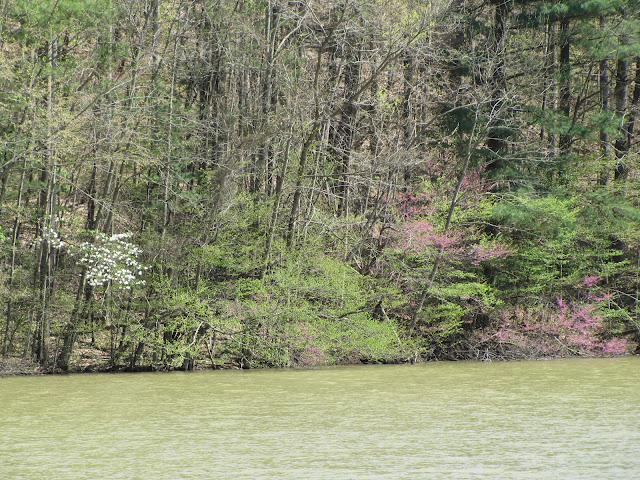During the week of April 17 to 23, we travelled to the Knobs Region of Kentucky. The hills are called The Knobs because they are cone-shaped with steep sides and altitudes generally less than 1000 feet above sea level. The Appalachian Mountains lie to the east.
 |
| Woodland Flowers |
We took a short hike in the John B. Stephenson Memorial Forest Nature Preserve to Anglin Falls, an area located near Berea, KY. The woodland floor was alive with a special floral covering of spring flowers. These are some of the things that we saw while hiking to the falls.
 |
The Trail to Anglin Falls |
violets
 |
| Long-spurred Violet |
This little violet is called a long-spurred violet because of the long spur on the bottom petal. It can also be distinguished by the purple spots on the petals.
 |
| Canada Violet |
Violets are the flower that seem to proclaim that spring has truly arrived. This is the Canada violet. It has a yellow tint to the base of the petals, and if you were to turn it over, the back of the top two petals is purple.
 |
| Woodland Phlox and a Tiger Swallowtail |
This tiger swallowtail is enjoying a sip of nectar from these native woodland phlox. They are sometimes called wild sweet williams.
 |
| Dwarf Crested Iris |
The dwarf crested iris is a showy, native plant that grows close to the ground. It is visited by hummingbirds, and like native columbine, provides an early source of nectar for them.
 |
| Jacob's Ladder |
Jacob's ladder is a native plant that gets the "ladder" portion of it's common name from the opposite leaves that look like a ladder. My first memories of it are those that I saw in my own grandmother's garden. The plant's fragrance is reported to be attractive to cats, and they will roll in it just as they do in catnip.
trilliums
 |
| White Nodding Trillium |
No spring woodland trip would be complete without trilliums to admire, and these woods provided plenty. A common name for them is Wake Robin so called because they appeared at about the same time the robin returned. They can be eaten and are used medicinally for diarrhea. Native Americans used them as an aid for childbirth.
 |
| Sessile Trillium |
The sessile trillium is also known as the toadshade trillium, the toad trillium and sweet Betsy.
 |
| Red Trillium |
The red trillium is sometimes known as the stinking trillium. Some people describe its smell as similar to that of a wet dog.
Redbud trees and dogwoods along the way.
This is a bird's nest that we spotted just off the trail. It is probably a Baltimore Oriole's nest although there are several other birds that will build a hanging nest.
As we neared the falls, the trail became narrower with some rocky area to traverse.
We saw this pickerel frog near the falls. Click on the link below to hear his call which has been compared to a snore. On the left side of the page, click on the family tab and then on Ranidae. Then click on Pickerel.
Beautiful wisps of orange and yellow, these native columbines were blooming
among the rocks.
This is Anglin Falls in April, a hike worth taking.
Now every field is clothed with grass, and every tree with leaves; now the woods put
forth their blossoms, and the year assumes its gay attire. ~ Virgil








I have enjoyed my visit hear very much, lovely blog with lovely photos. Thank you so much for visiting mine and becoming a follower, I have done the same with yours and will put your blog on my blog roll so that I can come back often.
ReplyDeleteWonderful!!
ReplyDelete